Tapping Into Your Dog's Ability...
Through Dog Agility Training
Is your dog the star of the dog park? Does he move like a speeding bullet? Jump like a jackrabbit? Does he make the cute poodles drool and the show-offs look like fools?
Whether you can attribute this energy level to his breed type or to his personality, if he's got it, he's got to use it. You can choose to commit to giving him plenty of outdoor play time, or...you can make the most of that inherent ability...by involving him in dog agility training.
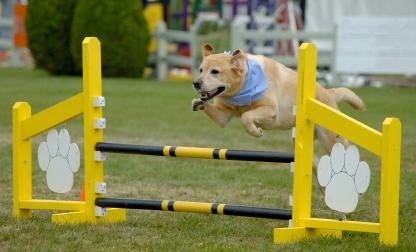
[google_ad:DOTR_CMS_468x60_InArticle1]
Dog agility. It's more than a growing trend. It's an outlet for your dog's natural, instinctual habits. It's a timed event, consisting of a roadmap of several obstacles, which your dog is asked to negotiate in a particular order, without fault, and under a judge-determined time limit. The pressure is on!
Think about what you know about your dog's ancestors' behavior. In the wild, dogs are required to chase and kill prey, and to also avoid being the prey. Imagine pursuit of a rabbit, for instance. That rabbit, when chased by a hungry canine, will hurdle rocks, slip under fallen logs, teeter on natural bridges, climb sheer slopes, and squeeze through brambles and thick brush. And if that dog is hungry, he'll be required to do the same. Considering the hardy survival of the canine population in the wild, we can deduct that they've been considerably successful in chasing those quick little guys. Because they're good at it!
Here's another thought. Humans are also designed to be agile. Your ancestors sprinted from saber-tooth tigers, traversed rushing rivers, zigzagged through dense forests, and chased food of their own.
So, as you may guess that I'm going to suggest...why not join your dog in a rewarding sport that plays into all that's natural and necessary..exercise, entertainment, satisfaction? All wrapped into a fast paced and elegant demonstration of adrenaline-fueled teamwork..in dog agility trials.
The History of Dog Agility
As with many of the most innovative and useful inventions, dog agility's birth was rather unintentional. At London's famous Crufts Dog Show in 1978, a horse-enthusiast was charged with entertaining the crowd between events. He designed a spectator event that employed dogs, doing equestrian-like feats. It was a hit, and came to the States in 1986, under the title of the U.S. Dog Agility Association. It was so much fun that it has become the fastest-growing dog sport in history.
Is your Dog an Athlete?
Or Would He Rather Just Take a Seat?
I hate to create an exclusive club here, but as with most sports, certain types are more conducive to success. Generally speaking, if your dog is descendant from a working breed, and is of medium build, then his chances of doing well are greatly increased. Among the best breeds for dog agility training are: Terriers, Shepherds, Collies, Retrievers, Sheepdogs, Spaniels, Poodles, Schnauzers, Cattle Dogs, Pinschers, Corgis, Canaans, Malinois, Papillons, and Tervurens. Mixed breeds are accepted by all dog agility clubs, except for the AKC.
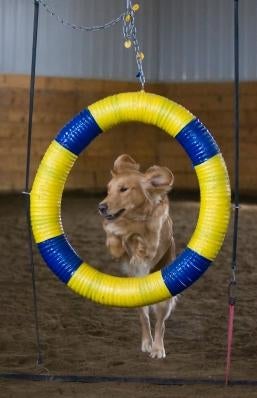
Some breeds are definite underdogs when it comes to agility training. Giant breeds like Great Danes and Mastiffs usually have neither the energy nor the desire to participate. Short-nosed breeds like Boxers, Bulldogs, and some Terriers have difficulty with activities that require heavy breathing. Breeds with short legs, like Dachshunds, can have a hard time clearing the jumps.
Age can also be a factor to consider. Puppies are excluded from trials until they reach 9 months of age, and it's recommended that dogs older than 8 years of age enjoy their retirement - work free.
As we discussed earlier, a lot of your dog's ability will be determined by his personality and energy level. Don't lose heart...if you've got a snorer, a giant breed, or a little shrimp...remember that no breed is excluded from dog agility trails. If your kid's got heart, then give it a shot. On the other paw, if your guy would rather lie on your lap and not break a pant, he may be better suited to a low-impact sport, the spectator type.
Benefits of Dog Agility Training
You've probably gathered, by now, from the information contained in my site, that almost any food, activity, or pastime that adheres to a canine's natural lifestyle (as in that of his ancestors) is best. Agility enhances all of your active dog's inherent abilities, plus one added element - YOU. So, that means it's doubly beneficial - because it caters to the natural order for you and your pooch.Once you begin, and continue to improve upon, your dog's agility training, you'll notice that he's more alert, vigorous, and confident. His problem-solving capabilities will multiply. The attention that you require from him will strengthen his bond with you, reinforce basic obedience commands, and improve his communication ability. The physical demands of the dog agility courses will hone his coordination, increase endurance, and improve his overall health through physical fitness. And all of that exercise will improve his behavior off the course - because as we all know - a tired dog is a good dog.
And, yes, as for you...all of the above benefits apply. Go ahead, read the list again - it's practically guaranteed!
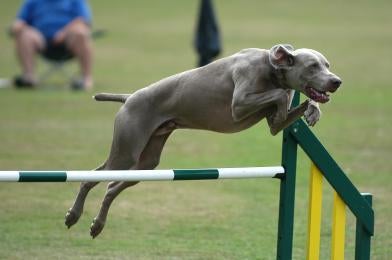
Are you Ready, Freddy?
Versed Things First
How's your dog's vocabulary? Is he well-versed in basic obedience commands? If your dog consistently obeys standard commands such as sit, stay, down, heel, etc., then you may be ready to embark upon the agility express. If your dog isn't confident in you and the commands that you use, he'll never trust you when you ask him to enter a dark agility tunnel. Yikes!
Besides your dog's vocabulary, his physical maturity needs to be a consideration. Dogs must be a minimum of 9 months old to compete, but that doesn't mean that every dog is ready at 9 months. Consider this: If your dog's breed is expected to reach its maximum weight at under 50 pounds, then he won't be finished growing until he's 9-12 months old. Likewise, breeds that are expected to tip the scales at over 50 pounds aren't likely to finish their upward pound-climb until they reach 10-14 months of age. Keeping this in mind, asking a puppy to clear regulation-height agility jumps before he is finished growing is a risky endeavor. His joints can't handle that kind of trauma. Jumps higher than a growing puppy's shoulder should remain out of the question. But, by all means, grounded equipment, like tunnels and boards, can be tackled as soon as the basic commands are mastered.
Dog Agility Training is no Gravy Train
Maybe you've watched an agility trial, and you and your dog are both anxious to compete. The adrenaline, the competition, the...slow down, Fido. Experts maintain that most dogs will need 6-9 months of daily, committed training before they're ready for the real thing. And it really is a journey - a very rewarding one at that.Bond with your dog in a playful atmosphere. Use toys to play fetch, tug-of-war, or Frisbee to reinforce commands and bring home the idea that work can be fun for your dog. You wouldn't join your first fitness club and sign up for the advanced class on the first day. Similarly, your dog needs to work up to his best physical condition. Gradually introduce equipment, one piece at a time, in the form of short agility tunnels and low jumps. With time and continual success, tunnels may be lengthened and bars raised to regulation level. This will not only build your dog's fitness and difficulty levels at a manageable pace, but will prevent injury and frustration.
Establish commands specific to each piece of equipment. This will be helpful when directing your dog in the ring (you'll have the map of the course, he won't). Also make sure that he's confident in commands to indicate fast, slow, right, left, up, down, heel, away, etc. to keep him on course. Reward good progress with treats and lots of love. Never reprimand for missed jumps or other fumbles. If you do, your dog will quickly become frustrated and want to give up. And, remember, if your dog approaches obstacles with his head or tail down, or if he shows any reluctance at the sight of the agility equipment, then it's not fun, and it may not be the thing for him.
Your veterinarian should always be a partner in your dog's health. Before beginning agility training, have your dog's joints, heart, lungs, and eyes checked. Additionally, extra weight can hinder his performance. A little belt-cinching may be in order, and your veterinarian can offer the best food plan for your little chunk.
If you like group support and good advice (who doesn't?), then look up a dog agility club in your area. You may also be able to find a trainer that specializes in agility training. Always keep it fun. Never focus on the prize, but rather, on the special bond that you will establish with your fun-and-fitness partner.
Don't Let Sub-Standard Equipment be an Obstacle to Success
Would you train for a marathon without running shoes? Or study for a spelling bee without a dictionary? Well then, you certainly can't ask Spot to be ready for an agility trial unless he's already familiar with the equipment. Likewise, if the equipment that you're using to train doesn't meet Dog Agility Standards, you will be sabotaging your dog's performance under the lights. Specialized retailers sell, and specialized trainers use, standard agility equipment. You may also build your own, as long as you're certain that it conforms with the Agility Standards put forth by the Agility Association with which you'll be competing.Here, I've included an overview of some of the most popular agility training equipment / obstacles and their descriptions:
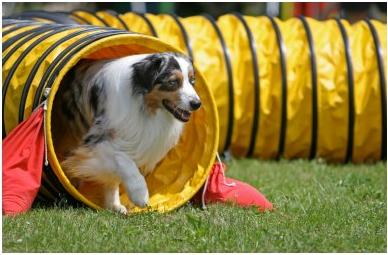
Tunnels:
Rigid tunnels consist of a wire frame, covered in vinyl. They are tubular in fashion and remain open for their entire length. They generally have the flexibility to be stretched out in a straight or curved line. Standards usually call for a tunnel 10-20' in length, 24" in diameter.Collapsed tunnels are constructed with a rigid, tubular entrance. Connected is an 8-10' fabric trailer, which the dog must push his way through.
Seesaw:
A seesaw, or teeter-totter, is constructed using a plank, attached and perpendicular to, a center support pole. The plank is weighted on the entrance side so that it will automatically return to the starting position. The dog enters on the lowered side. As he reaches the center of the plank, his weight will cause the plank to shift, like a seesaw, and he will walk down, and off the exit side.
Dog Walk:
A dog walk is built using one center plank, 4' from, and parallel to, the ground. Two other identical planks serve as the entrance to and the exit from this center plank, mounted at opposing angles from it to the ground. All 3 planks are to be 9-12" wide and 8-12' long.
Pause Table:
The pause table is just that - a table on which the dog pauses. It can be any 3' by 3' table or platform, 8-30" from the ground (differs per height class). The dog jumps onto it and lies down for 5 seconds.
Pause Box:
A pause box is used just like a pause table, except that it is simply a 3' by 3' square marked off with tape or other material on the ground.
Jumps:
A tire jump is built by supporting or suspending a tire from a frame. The dog must jump through without touching the tire.Not a high jump, the broad jump is made by adjoining low platforms on the ground.
The single jump is constructed of two vertical side bars, with one adjustable horizontal bar for jumping over.
The double jump is fashioned after the single jump, but rather consists of 2 sets of vertical supports, placed one set in front of the other, with horizontal bars mounted at differing heights.
Additionally, the triple jump is built using 3 sets of vertical supports and horizontal bars, at varying depths and heights, much like stair steps.
Finally, a panel jump also uses vertical supports, but rather than a bar for jumping, a solid, removal panel is utilized. Panels of varying heights are used for different height classes.
A-Frame:
A-Frames are constructed from 2 planks, placed at upright angles, to form a rough "A" shape. Each plank is 8'-9' long and 36" wide. They are hinged at the top, where they meet. Contact zones of 36-42" are required on the entry and exit sides, and grips or ridges are necessary to help the dog in navigating up one side and down the other.
Weave Poles:
Weave Poles are upright and fixed in a straight line, 20" from one another. The dog must weave in and out of the 3' tall poles, in a zigzag fashion, entering with the first pole at his left shoulder.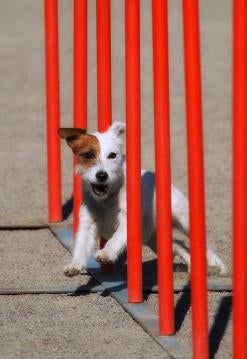
Solid, standard, equipment is essential to your dog's agility trial success. If he's inadvertently injured on sub-standard obstacles, he will be skittish and fearful of ever mounting that apparatus again. If he shows up to a trial and is introduced to foreign equipment, he will be unable to perform. Set him up for success. By purchasing, renting, borrowing, or building quality benchmark equipment, you will elicit a performance of equal excellence.
An Array of Agility
Just like dog biscuits...dog agility courses come in a variety of flavors. Levels are cumulative. You'll start as a novice, on a simpler course, and move on to more difficult courses, if you choose to do so. Here are some of the more well-known types of agility courses:
Standard Agility:
This type of courses generally consists of 15-22 obstacles, of varying types - contact, tunnels, weave poles, jumps, etc.
Jumping:
Jumping agility courses contain mainly...you guessed it...jumps. There are no contact obstacles, though a few tunnels and/or weave poles may be tossed in.
Power & Speed:
The Power part of this course is a sort of pre-qualifier. If the dog is able to navigate the course without any faults (untimed), he will then be permitted to enter in the timed trial (test of speed).
Juniors:
Junior...as in the handler, not the dog. If you are under the age of 18, you and your dog can compete in this category to win medals or rosettes. Within this agility class, levels range from beginner to senior, and build in difficulty and number of obstacles.
Teams:
Two handlers with two dogs, or three handlers with three dogs are each responsible for completing a portion of a standard dog agility course. A baton is passed, much like in an all-human relay race.
Gamblers:
Gambling is not for the beginner or under-confident team. The first half of the course is run in a sort of freestyle, where the handler pre-determines the obstacles that the dog will navigate, and the order in which it will be performed. When the judge indicates time, the dog must then switch to a pre-determined course order, much like standard agility. The big challenge here...the handler cannot run alongside the dog! He or she must stay behind a line and give commands from a distance.
Snooker:
Sharpen your pencils, folks. This course will test your mathematical skills. On the course, you'll find jumps, consisting of three red ones, all numbered "1". There are also 6 others, numbered "2" through "7". The dog must begin by jumping a red one, then any other non-red jump. Then another red...and so on. The numbers on the jumps are then added up to determine the final score. As with Gamblers, there is an opening and a closing portion.Of course, each Dog Agility Association's rules vary, and not every one is offered through every organization. And, there are undoubtedly more courses available that are unique to each association. Do your homework - find an organization that is active in your area. Talk to local pet supply retailers, trainers, and shelters for more information.
Running with the Big Dogs
Before attending your first dog agility trial, there are a few things that you'll need to have in order. First, be sure that your entry fee is paid in full - well in advance of the deadline. Be certain that you and your dog are completely confident with every obstacle. Run them as if you were at competition, then, when trial day comes, there will be no nasty surprises for your dog.By now, you should have familiarized yourself with the standard agility equipment used by the association of your choice, and you should know what rules will be imposed during the trial. Surprises are never a catalyst for success.
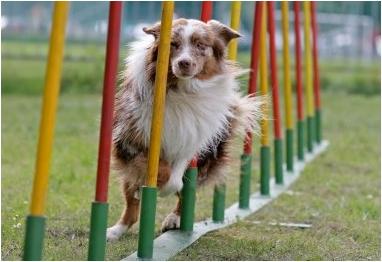
Ready...Set...Go!
Oh, your dog is looking good. He's clearing the jumps with ease, weaving like a pro, and his new slim, trim figure has all the girl dogs drooling. You've made all of the arrangements for your first agility trial. So now...what to do once you get there?Know your organization. No leniency will be provided for misunderstanding. Disqualification is inevitable if rules are broken - excuses will not be accepted.
Plan to arrive at the site of the trial at registration time, not your run time. It's conceivable that your run time may be changed, and it's always helpful to your agility career when you have extra time to spend with professionals, helping out and learning from them.
Take along whatever your dog needs to be comfortable while he's waiting for his big moment. A safe crate and his favorite doggy toy can go a long way toward making him feel at home. Food and water are also musts. Take some time to play, so that he's not brimming over with blinding energy, and some time for rest, so that he's alert.
Agility courses generally cover about 180 linear yards within a 10,000 square foot area. You will have the opportunity to assess the course before trial time. Showtime will be the first time your dog sees the course, however. No treats, toys, or leashes are permitted in the ring at trial time. You may escort your dog to the start line on a leash, but it must then be abandoned.
Your dog will enter agility trials at the Novice level (a.k.a. Starter or No Title). As he accumulates Q's, or Qualifying Runs, he will be able to move onto the Open and Elite categories. He will earn a "Q" if he completes a run under the judge-determined Standard Course Time (SCT), without a single fault. Any of the following are considered a fault:
- Any part of the dog touches any part of a jump (obvious if a bar is knocked from the jump).
- The dog exits a piece of equipment without touching the contact zone with at least one paw.
- The run goes over the SCT.
- The handler makes contact with any equipment.
- The handler makes contact with the dog.
- The obstacles are taken out of order.
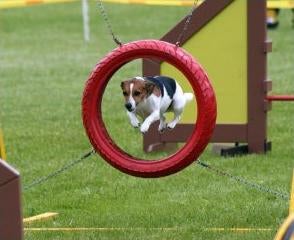
- If the dog soils the agility ring.
These are somewhat standard, but remember, each association's rules are unique.
No matter your dog's category, skill level, or association affiliation, one concept rings true for all agility participators. RELAX. Have fun. For your dog, this trial is just another run in the park, another practice in the back yard. Don't let nerves get the best of you - so that the crowd, and the judges, can see the best of your dog.
Porch Potatoes Need not Apply
Every dog is special. Maybe yours is a sports star. Or, maybe he's more like the manager, or the water boy...or the disinterested spectator. No matter, it's important to find an activity that fits your boy or girl to a tee. Every dog needs a job - likes to feel needed and necessary. When you've got one that exhibits everything necessary for dog agility training, you're going to have one happy tail-wagger in that ring.So, tap into that natural ability. Go for agility!
of dog agility training in action.
Please consult the services of a Professional Dog Trainer, Behaviorist or Veterinarian before implementing any of the advice contained on this site.











 Your Privacy Choices
Your Privacy Choices